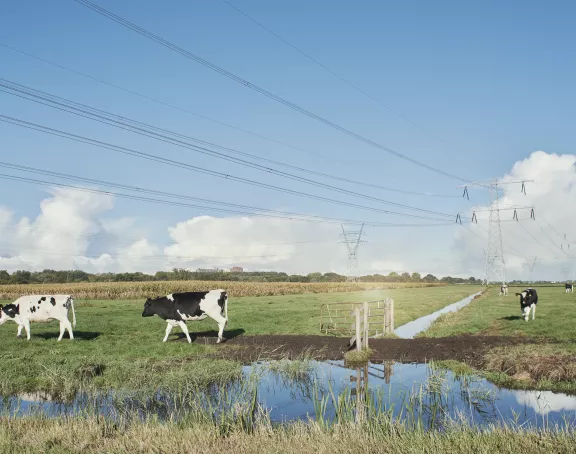Environmental rules in the environmental plan
With the arrival of the Omgevingswet (Environment and Planning Act) as of 1 January 2024, the concept of the omgevingsplan (environmental plan) will make its appearance. Under the Environment and Planning Act, every municipality will have a single environmental plan for its territory, which will include rules for the physical living environment. In this blog, we address the significance in practice of the environmental plan under the Environment and Planning Act, with a focus on the environment. We explain which environmental rules may apply under the environmental plan, what the main changes are and what this means in practice.
This post is part of the Environment and Planning Act blog series. In the run-up to the Environment and Planning Act (the Act) that will enter into force on 1 January 2024, we each time highlight a specific topic of the Act in this blog series.
The concept of the environmental plan
The environmental plan is the successor to the zoning plan, but with a broader scope. See our earlier blog post on the main outlines regarding the environmental plan: "Het omgevingsplan (blogreeks Omgevingswet)". For the environmental aspect, the environmental plan is more important than the zoning plan of the Wet ruimtelijke ordening (the Spatial Planning Act), as more environmental aspects are regulated through the environmental plan. In addition, more activities are regulated by the environmental plan and less than before through general rules of the state, such as the Activiteitenbesluit milieubeheer (Environmental Management Activities Decree; the Abm). We explain this in more detail in the following paragraphs.
General environmental rules for activities in the environmental plan; changes from old law
In the environmental plan, rules can be set about activities that have or may have an impact on the physical living environment (Article 4.1(1) of the Act) within the area of the municipality. Some environmentally harmful activities are regulated only in the environmental plan and no longer in state rules, and some environmental subjects are regulated entirely (or almost entirely) in the environmental plan and not in state rules. We explain this in more detail below.
Activities regulated in the environmental plan
All activities that are not designated in Chapter 3 of the Besluit activiteiten leefomgeving (Decree on Activities in the Living Environment; the Bal) as a so-called milieubelastende activiteit (environmentally harmful activity; an MBA) will be regulated at local level in the environmental plan under the Act (see also our earlier blog post FAQ: Van inrichting naar MBA). According to the Explanatory Memorandum, examples of businesses and activities that are not regulated in Chapter 3 of the Bal – and that can therefore be regulated in the environmental plan – are hotels, guest houses, restaurants, catering companies, discotheques, event halls, residential and daytime recreation, sports facilities, retail trade, supermarkets, and animal boarding houses, shelters and clinics (Stb. 2018, 293, p. 568). These activities used to be regulated at the state level, in the Abm. Unlike under the old law, the environmental effects of these activities are therefore regulated only at the municipal level under the Act.
It is possible that the environmental effects of a company at a certain location are partly regulated by the Bal and partly by the environmental plan. This is the case, for example, if part of the company qualifies as an MBA that is regulated in Chapter 3 of the Bal, and another part of the company does not fall under the designation of Chapter 3 of the Bal and is thus not regulated by the Bal. An example is an IPPC establishment for making cardboard (designated in Article 3.75 of the Bal) on the one hand, and an office that does not functionally support this establishment on the other.
Environmental aspects in the environmental plan
An important change under the Act compared to the law before them is that certain environmental topics are mainly regulated at municipal level and not, or to a lesser extent, at state level. Previously, it was therefore less clear to what extent environmental topics could be regulated in the zoning plan. Now the laws and regulations have made a clear choice on which environmental topics must in any event be regulated in the environmental plan.
This applies, for example, to the subjects of air quality, external safety, noise, vibration, odour and soil. Those topics are mainly regulated in the environmental plan. The instruction rules in Chapter 5, paragraph 5.1.4, of the Besluit kwaliteit leefomgeving (Living Environment (Quality) Decree; the Bkl) determine for the environmental topics of air quality (paragraph 5.1.4.1), noise (paragraphs 5.1.4.2 and 5.1.4.3), vibration (paragraph 5.1.4.4), soil (paragraph 5.1.4.5) and odour (paragraph 5.1.4.6) what rules must be included in the environmental plan. The municipal executive must comply with those rules if they appear in an environmental plan. An example of this is that the environmental plan must specify the noise levels allowed on noise-sensitive objects (Article 5.65 of the Bkl). The instruction rules in the Bkl sometimes do and sometimes do not leave room for the municipal council to weigh up the content of the plan rules. This therefore depends on the specific instruction rule. Municipalities have until at least 1 January 2032 to ensure that the environmental plan complies with the Act (see also below in the next paragraph). They would be well advised to arrange this before then, to avoid a conflict with the instruction rules of the Bkl.
A key aim of the Act is customised governance because of the variation in the physical living environment in the Netherlands. Through flexibility in the rules, local circumstances and developments can be taken into account as much as possible. For this reason, there are various forms of administrative deliberation space in the Bkl, which should result in decentralised authorities being able to apply the national regulations flexibly. Examples of types of administrative latitude in the Bkl are the possibilities of using exceptions, bandwidths, deviation possibilities and customisation for activities. For example, municipalities can work with a bandwidth for the aspect of noise and can set rules appropriate to the location and nature of activities in an area (Stb. 2018, 292, p. 194, 211 and 231).
Because of these changes, companies under the Act will have to consult the environmental plan much more often than before, now that the environmental topics mentioned are largely regulated in the environmental plan.
Transitional law; environmental rules in environmental plan in transition phase from temporary to new environmental plan
From the entry into force of the Act on 1 January 2024 until 1 January 2032, environmental plans will be subject to a transitional situation. This is also relevant for environmental rules in the environmental plan. We explain this in more detail below.
The transitional law of the Act stipulates that all former zoning and management regulations will be part of an environmental plan after the entry into force of the Act (Chapter 22 of the Act). As a result, municipalities will formally have a single area-wide environmental plan as soon as the Act enters into force. The environmental plan will then consist of a temporary part and a new part. The temporary part consists of the (spatial) rules from various expired instruments, such as zoning plans. That temporary part also consists of environmental rules. For the temporary part, municipalities will have to adopt their own environmental plans by 1 January 2032 at the latest, as all rules from the temporary part will then lapse (Article 22.6(3) of the Act and Stb, 2023, 267).
As mentioned above, environmental plans will contain more environmental rules and regulate more activities, partly in view of the 'decentralised, unless' principle. It was assumed that municipalities would not be able to regulate all these topics themselves right from the entry into force of the Act. Therefore, a provision was made for a so-called 'dowry'. That is a part of the environmental plan containing rules on MBAs that were legislated at the state level under the old law, such as the Besluit omgevingsrecht (Environmental Law Decree; the Bor) and the Abm, and that fall within the competence of the municipality under the Act. From the entry into force of the Act, all environmental rules from the dowry will be part of the environmental plan, in the temporary part of the environmental plan, and thus apply directly. Each municipality will have a dowry from the entry into force of the Act, containing environmental rules for activities such as hospitality, recreation and retail, and on topics such as soil and noise.
The environmental rules in the dowry cover, for instance, energy saving, soil management and noise, and apply to MBAs. These rules do not apply to all types of businesses. For example, the rules from the dowry do not apply to businesses that already had an environmental permit with permit requirements before the Act came into force (Article 22.1(2) of the environmental plan rules from the dowry; the environmental plan rules). Also, the rules do not apply, for example, to housing or construction works. The dowry also provides in several articles that certain rules do not apply to activities designated in Chapter 3 of the Bal or parts thereof. For example, Article 22.51 of the environmental plan rules provides that the rules on energy conservation from the environmental plan do not apply to environmentally harmful activities designated in paragraphs 3.3 to 3.11 of the Bal. In our blog post Blogreeks Omgevingswet: De bruidsschat in het omgevingsplan, we address the dowry in more detail and discuss to whom the rules from the dowry apply.
On 1 January 2024, mainly the environmental rules from the dowry will be important for companies. Only later, when the municipal council adopts them, will the general environmental rules from the permanent part of the environmental plan apply. It is therefore important for companies to check which environmental rules from the dowry (and the rest of the environmental plan, insofar as it already contains environmental rules) apply to them and whether customised regulations may still need to be requested.
Environment 'customisation rules' in the environmental plan
As mentioned above, customised rules may be included in the environmental plan (Article 4.6 of the Act). Customised rules are rules that deviate from other (higher) general rules and apply, for instance, to unforeseen situations or local circumstances. Under the Act, many general environmental rules are contained in the Bal. With customised rules, the municipal council can deviate from the general environmental rules in the Bal in the environmental plan. The Bal determines the subjects on which customised rules can be set, and the content of these rules. This follows from the general authority from Article 2.12 of the Bal to set customised rules and the specific provisions per section of the Bal on the interpretation of these powers.
Article 2.12 Bal states that deviation from paragraph 2.7 and Chapters 3 to 5 of the Bal is possible, unless the Bal provides otherwise. The Bal fleshes out this authority in several places. One example is Article 4.8 of the Bal, which states that customised rules on Seveso establishments may only be supplementary to the general rules in the Bal. Another example is Article 4.37 of the Bal, which stipulates that in certain cases it is possible to deviate from the emission limit values for large combustion plants from Article 4.36 of the Bal, but that the deviating emission limit value from that customised rule may not exceed 50 mg/Nm3. Thus, within the frameworks provided by the Bal, there are possibilities to deviate from the Bal in the environmental plan with a customised rule. If there is reason to do so, companies can investigate whether they can deviate from the Bal with a customised rule.
Significance for practice
Under the Act, general rules for environmentally harmful activities will not only be in the Bal, but also in the environmental plan. This is a shift from the system before the Act, where general rules mainly applied at state level. This shift applies in particular to the subjects of air, noise, vibration, odour and soil. Under the Act, more environmental aspects and more activities will therefore be regulated in the environmental plan than is currently the case in the zoning plan. For businesses, it is important to pay attention to the relationship between the general state environmental rules in the Bal and the general environmental rules in the environmental plan. If an MBA is not designated in Chapter 3 of the Bal, it may be subject to general environmental rules from the environmental plan. Fewer activities are designated in Chapter 3 of the Bal than are currently regulated in the Abm.
The municipality will therefore have more room to regulate environmental topics, either because the instruction rules from the Bkl give the municipal council room for manoeuvre when adopting planning rules on these topics, or because the municipal council will have a fairly broad power to deviate from the general environmental rules in the Bal by means of customised rules. Municipal environmental rules are therefore important – more important even than under the law before the Act. This may also mean that companies will consult more with the municipality on environmental rules than is currently the case. This probably applies to a lesser extent to the 'complex companies' from paragraph 3.3 of the Ball. An example of a complex company is a Seveso establishment. Such companies are largely regulated via regulations from the environmental permit. The Provincial Executive is the competent authority for that single permit (Articles 4.6 and 4.16 of the Environment Decree). Such companies will therefore mainly deal with the Provincial Executive.
In conclusion
This post is part of the Environment and Planning Act blog series. An overview of all blogs in this blog series can be found here.
Further information on the background and adoption of the Environment and Planning Act can be found on our webpage www.my.stibbe.com/mystibbe/pgo. Our webpage includes the consolidated version of the Environment and Planning Act, whereby all the articles of the law are provided with a relevant explanation based on the legislative history.



